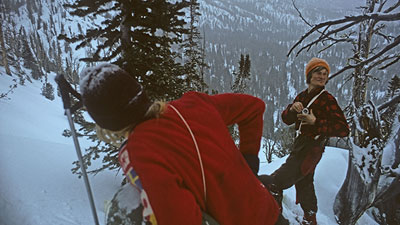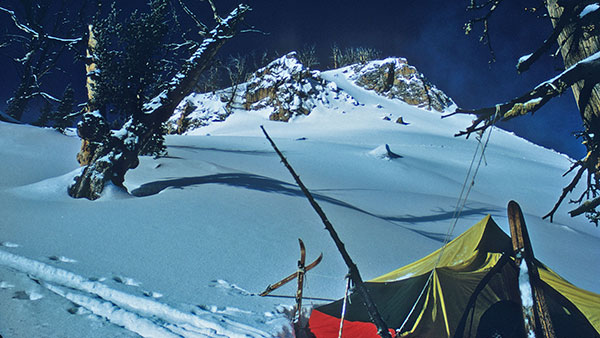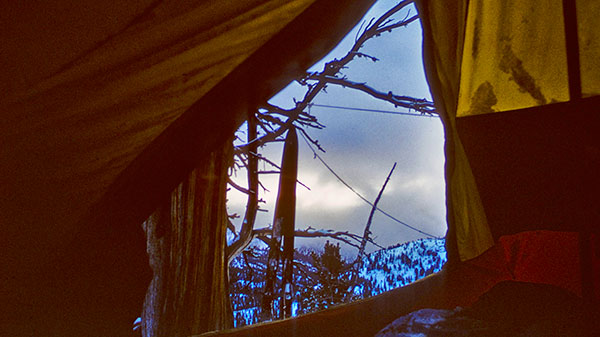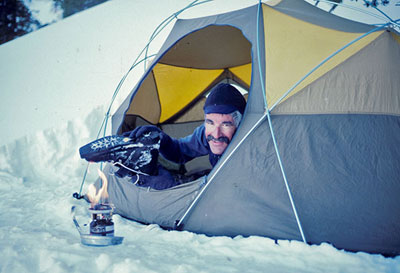By
Ron Watters
From Ski Camping: A Guide to the Delights of Backcountry Skiing. Copyright 1978 and 1989 by Ron Watters. With minor revisions made in 1998.
One of the most interesting campsites I've ever experienced was set up unexpectedly after seven days of a trip into the snow-shrouded Big Horn Crags in the Idaho Primitive Area. Four of us were approaching a critical point in our traverse. The one pass we were looking for was a low saddle between higher and more rugged peaks. It was the only way to cross the backbone of the range and reach the other side of the divide.
 Snow swirled as we gathered around the map. We couldn't see any landmarks, yet we were anxious to keep moving. We were convinced that the slope ahead of us was the right direction and we continued climbing higher and higher.
Snow swirled as we gathered around the map. We couldn't see any landmarks, yet we were anxious to keep moving. We were convinced that the slope ahead of us was the right direction and we continued climbing higher and higher.
After an afternoon of climbing, we reached the top of the ridge. If we had made the right choice, it would be an easy ski to the pass. We dropped our packs and skied to the edge, only to peer over an abrupt cliff that fell a thousand feet to disappear mysteriously in the clouds.
Obviously the wrong choice.
After the clouds cleared enough we could see our objective a half mile to the north across the basin.

Although it was somewhat unsettling to know we would have to make an unplanned camp on an exposed ridge, it turned out to be the most spectacular winter camp I've ever made. Eventually, the clouds began to lift. Through the opening of our tent high on the ridge, we watched the framed moving picture of clouds billowing and tumbling, now covering, then breaking dramatically to unveil snow-burdened peaks.
Although high, exposed ridges can be dangerous during bad weather, they're also one of the most scenic locations for a winter campsite.

Selecting a Campsite
When the weather looks kind, a camp in a high location overlooking the surrounding scenery can make a trip. You are out there for enjoyment and beautiful scenery and views should certainly be one consideration when choosing a campsite. Other concerns are:
-
Wind protection. Trees, outcroppings, and a large pine all provide protection from wind. Watch for loaded branches of snow, and place the tent so that you are not directly under them.
-
Avalanche hazard. Avoid camping on any slope or at the bottom of any slope that would have the remote possibility to avalanche. Learn to check the surroundings for vulnerability below open areas, steep, narrow chutes or overhanging cornices. It is always important to learn the telltale signs of avalanche conditions.
-
Water availability. This is especially important. Having a source of water from an open stream saves a lot of fuel and time melting snow. Often, however, the streams are frozen or covered by snow. On a recent trip through a wilderness area, we found running streams at only two of the ten campsites.
-
Altitude. Avoid valley bottoms and low meadows. Cold air will settle in lower areas and make a chilly, frosty camp. Benches and platforms above the meadow or valley will be warmer.
-
Terrain. The easiest location for a tent is obviously a flat area, but, if not available, simply make a platform by using the shovels and digging out a place in the snow. This is one of the luxuries of winter camping: snow can be moved. Once a site has been selected, the members of the group should divide up the tasks of setting up camp, putting up tents and making a kitchen area. The temptation might be to sit and relax but it's important to get the heavy work over with while still warm and energized. Work has the attractive advantage of keeping you warm.
Putting up the Tent
You are probably used to setting up your tent, but there are few additional considerations in the winter.
-
Stamp out a level platform with your skis on, and use them to compact the snow. You can compact it further by stamping it out with your boots, but it isn't necessary. You can make it level by shoveling out a platform.
-
Place the entrance downhill. Cold air will flow into a tent facing uphill.
-
Place the tent ninety degrees to the wind. This will help keep the tent door free from drifting snow.
-
With your skis on, stake out the tent. If you have a dome or tunnel tent, put the poles in place and then stake it out. Throw everyone's pad inside. Then, as you slip into the tent, the pads will cushion you and prevent pits in the snow under the tent. After some time, the snow firms up and provides a platform to sleep on. An unjustified fear of those first trying winter camping is that the snow will melt on contact with the tent, bodies or bag. That doesn't happen.
-
Skis and ski poles can be used for tent stakes if you've elected not to bring any snow stakes with you.
-
In front of the tent door, dig a square hole one to two feet deep. This will serve as a porch when brushing off boots or changing socks.
Kitchen
While some are setting up the tent, others can be constructing the kitchen. If it is bitter cold, then you may dispense with the kitchen and do all the cooking in the tent while wrapped in sleeping bags. In most winter weather, however, cooking can be done outside. After one too many spilled cups of soup on my sleeping bag, I avoid tent cooking whenever possible.
The kitchen area can vary in size depending on how much time you have and how energetic you feel after skiing all day. Ideal kitchen areas are three to four feet deep rectangular holes shoveled in the snow. The length should be five to eight feet and the width three to four feet. A shelf should be made in the snow approximately one foot below the top the hole where a stove can be set and all cooking is done. If you are tired, a kitchen may consist of a small hole deep enough to stand in and to keep the stove out of the wind.
The nice thing about such kitchens is their convenience. If deep enough, you can work with the stove and do all of the cooking without bending or kneeling. Most importantly, the stove is protected from the wind. Like kitchens at home, they're places where everyone from the party congregates and chats about the day's activities.
The most ambitious kitchen I've ever seen was about eight feet deep and covered with a tarp. It had shelves, a cooking area, and storage.
When the kitchen is constructed, get the stove out, fill it up, and start melting water right away. A small ensolite pad placed under the stove will help insulate it from the snow and keep it working more efficiently.
Changing Clothes
While setting up the tent and constructing the kitchen, you'll be working and keeping warm. But, sometime after those chores the activity level drops and you'll need to be careful to put on dry, warmer clothing before you chill. Most skiers change into a dry pair of socks and then pull on a pair of down or fiberfill booties. Over the booties, a pair of water-resistant overboots can be worn for walking around in the snow. The bootie-overboot combination does the trick when it comes to keeping warm while standing around in camp. It feels good to get out of ski boots.
Cooking
By the time members of the group have changed into warmer clothing and laid sleeping bags in the tent, the water on the stove is likely to be hot. First on the program is a hot drink for everyone. Cocoa, tea, hot jello--whatever everyone enjoys. The idea is to start replacing lost fluids right away and at the same time to provide extra heat to the body.
You should consume at least a gallon of water each day. Often skiers only get quart of water during the day from their water bottles if no open streams are available. That means another three quarts will have to be consumed at breakfast and supper. Be aware of this quantity because being thirsty isn't always a reliable indicator of being dehydrated. Dehydration can lead to fatigue, contributes to making you colder, and can lead to hypothermia. Drink water whenever you can and be conscious of your daily water intake. I try to keep drinking liquids to the point of forcing it.
For the main course, cooking will be easy since you've taken care of all the preparation before leaving on the trip. Freeze-dried foods are simply dropped into the hot water and allowed to soak for a few minutes. If you are preparing one pot meals with grocery store ingredients, all the mixing and combining of ingredients has been done at home. All you need to do is to add it to a pot. Put spoonfuls of butter or margarine on the food to raise its caloric value. When supper is finished, keep the stove going for more hot drinks.
Pollution
Winter is as necessary a time as any to minimize environmental impact. Vegetation that can be trampled and destroyed at summer campsites is well protected under a layer of snow. The problem of winter camping is human waste. One characteristic of freeze-dried food is that it keeps you regular. The winter camper should take care to find a bathroom site well away from any streams or drainage paths. If winter campers are careless, the spring melt will wash all the preserved human waste from the winter into the streams during a short period of time, fouling the stream early in the season.
Pick up litter. Don't be conned into believing that the protective white blanket will miraculously sweep away any litter. Particularly be careful not to drop wax wrappers. If you bring oranges, carry out the peels. Pine boughs should only be used for emergency shelters.
An abandoned winter campsite not properly cleaned up can look quite ugly in its white surroundings especially if another party happens along within the next few days. Out of courtesy, I throw snow over urine marks and food spills before leaving. I have skied by winter camps that were filthy. At one camp left by a large, commercial "winter survival" school, a companion found unused tea bags, tops to cocoa packages, and, next to a rather large pile of human feces, a dollar bill.
Stove Safety
Stoves are dangerous if handled improperly. If possible, cook outside the tent to be safe. It is not always possible, and some cooking probably will have to take place in the tents. It may be also feasible to use the stove just outside the tent door.
Whatever you do, treat the stove with caution. Stoves produce carbon monoxide. Try to do any fuel filling out in the open. A few points to remember:
-
For stoves which need to be primed, solid fuel or fire starter pellets are the safest, especially when cooking in tents. White gas used as a primer flares up violently while solid fuel burns predictably.
-
Avoid wrapping the stove in any kind of insulation. Use only insulation under the base of the stove.
-
If the tank becomes so hot it can't be touched, turn off the stove and let it cool.
-
Some stoves have a safety release valve in the cap. If too much pressure builds up gas will escape out of the safety release. Usually the escaping gas will ignite throwing flame away from the stove. Keep the cap pointed away from you and outside the tent door.
-
Fill the tank before starting to cook. If you have to fill the tank while cooking, allow it to cool off before fueling. A funnel is a considerable help in filling.
-
Gas can assume the air temperature and can cause frostbite if spilled hands during subzero days.
-
After filling, replace the cap on the fuel bottle and place it far away from where you are operating the stove.
-
Because stoves produce carbon monoxide gas, always make sure your tent, snow cave, or igloo is well ventilated.
Water
In the winter when water surrounds you, it's surprising to be worried about it. Yet, making sure you have enough of it is a constant concern. If you're in an area where open streams or lakes exist, you'll have a ready supply. Often, however, you'll find that all water has to be melted. It takes time and fuel to melt snow, but avoiding fatigue, headaches, and eventually dehydration is worth it.
Melted snow water in a pot never tastes as good as from a mountain brook. You can help its taste and speed up the melting process by pouring a bit of water left over from a water bottle in the bottom of the pan. Allow it to warm and add snow, just enough that the snow doesn't soak up all the water. If you're cooking inside your tent, pile up bits and chunks of snow just outside the entrance, in order to have your snow supply within reach. Bring plenty of juice mixes, cocoa, coffee or tea to help disguise the pan taste.
Getting Settled
To make your sleeping area more comfortable, position yourself in a desired location, then bounce up and down jamming your buttocks into the pad, making a depression for your hips. This will help keep the pad in position as well as being more comfortable for sleeping.
To avoid confusion and accidents, it is best for tent mates to get in the tent separately. Brush snow off clothing. Boots can be removed while sitting in the tent and hanging your legs over the porch. Knock snow off the boots before bringing them in so the tent doesn't get wet.
A candle can be tied to a tent's center pole or set on a pot. Some skiers bring small candle lanterns to hang in the tent when arranging and sorting equipment. I like to write in my notebook before retiring at night and a candle gives enough light.
Keeping Warm
Those who have never tried winter camping may have steered clear of it for fear of freezing during the night. It's an understandable concern, but unjustified With a few simple precautions, no one is going to be found a frozen zombie the next morning. While the proper sleeping bag will keep you from freezing, here are some helpful hints for staying comfortably warm:
-
The important first step is to get into the sleeping bag warm. Don't expect the sleeping bag to warm you. It can, but you'll be ahead of the game if you are warm when you first climb into the bag. If you're not warm, drink lots of hot liquids or go for a quick ski to get the blood circulating.
-
Eating something right before you hit the sack can help. It also gets the blood circulating for the digestive process and provides a little extra energy.
-
Keep sleeping bags close together in the tent. Take advantage of some of your partner's heat.
-
Wearing clothing inside the sleeping bag is the most important aid to increasing your comfort at night. If you're not warm enough, put on a hat. Wear shirts and jackets if you are still chilly. Still more warmth can be obtained by wearing down booties and mittens.
-
Keep the bag's hood closed up, leaving only a small opening for your mouth. The hood drawn up in this way helps to contain heat from the head and neck area.
-
If you're still cold, get more insulation under your body by placing your pack under the pad and any left over clothing under your bag.
-
If you happen to be sleeping outside and not in a tent, stay warmer by finding a protected location out of the wind. Sleep under cover such as under branches or build a snow shelter.
-
If you're still cold. think about getting a new bag and thicker pad. Some of us have systems that simply can not handle colder temperatures as well as others. If you become very cold, don't be afraid to wake someone.
Cold Boots
 Boots in bed? Some do, some don't. If you don't, you can expect stiff, frozen boots in the morning. While having them in the bag can be a little uncomfortable, those who do will have toasty boots. Place both boots in one stuff bag or each In their own bag and arrange them someplace in the sleeping bag where it's comfortable. Moist mittens and socks can be dried by placing them underneath your shirt next to your warm skin.
Boots in bed? Some do, some don't. If you don't, you can expect stiff, frozen boots in the morning. While having them in the bag can be a little uncomfortable, those who do will have toasty boots. Place both boots in one stuff bag or each In their own bag and arrange them someplace in the sleeping bag where it's comfortable. Moist mittens and socks can be dried by placing them underneath your shirt next to your warm skin.
Gaiters commonly freeze up. Before retiring, knock the snow off and place them under your bag. Or put them in the same stuff bag as your boots and take them to bed. If you have problems with the zipper, rub on snow seal or candle wax.
Mornings
The first person awake in the morning should bravely get up and fire up the stove. He or she can get the others going by serving them hot drinks in their sleeping bags. However it is done, the first thing to do is to prepare hot drinks.
If I put the stove just outside the tent door, I can heat water in the morning without leaving the warmth of my sleeping bag.
Boots, which have been kept warm in sleeping bags all night, can be tied together and hung around your neck underneath a jacket. This will help keep them warm until you're ready to leave.
Keep drinking hot drinks after breakfast to start the day with a good supply of fluids. Even while packing, pause and sip a little cocoa, hot liquid jello or whatever.
The last thing to do after the tents are down and packs packed is to remove down booties and put on your boots. The boots will be warm from hanging underneath your jacket. Warm boots with warm feet is the only way to start touring. Feet are one of the hardest parts of the body to warm up. If they start to get cold, it may be a couple of miles down the trail before they again feel comfortable.
Pack overboots and down booties, check to make sure the camp is clean, and you're off for another day.
[END]
(More information on the book Ski Camping. )
